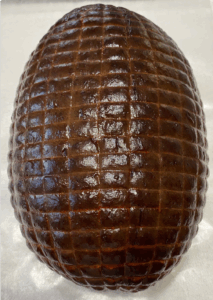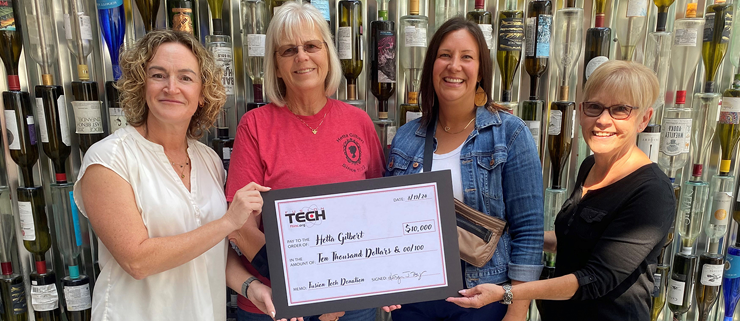In this article, we continue our series on reverse engineering meat products—this time focusing on a popular choice: honey ham. By examining USDA labeling rules, ingredient statements, and formulation calculations, you’ll gain a clear understanding of how to recreate a compliant and high-quality product from scratch.
Let’s start with recreating a straightforward product- like honey ham. The label states the following:
Honey Ham With Natural Juices
Cured with Water, Honey, Dextrose, Contains 2% or Less of: Salt, Potassium Lactate, Sodium Phosphates, Sodium Diacetate, Sodium Erythorbate, Sodium Nitrite.
The first thing we see is the product name “Honey Ham”. According to USDA regulations, the product will need at least 3% Honey in the formulation. Remaining sweeteners cannot exceed 50% of the honey percentage- This gives the first clue of the formulation.
The statement “with Natural Juices” tells us the product type. This is based on the USDA FSIS Protein Fat Free (PFF) guidelines and is used to determine how much water and other ingredients are allowed in the formulation. The PFF will ultimately determine your injection percentage. There are 4 criteria for cooked ham with their minimum PFF values:
- Ham (20.5)
- Ham with Natural Juices (18.5)
- Ham Water-Added (17.0)
- Ham and Water Product – X% of Weight is Added Ingredients. (<17.0)
The calculation below is derived from the Process Inspectors Handbook and should be used as a guide to stay in compliance with the USDA.
Percent Meat Protein by Analysis X 100 = PFF
100 X Percent Fat by Analysis
Most of the ham products in the marketplace fall in the Natural Juices or Water Added criteria.
Looking At Ingredients
The next step is to look at the ingredient statement. This gives you a basic understanding of what ingredients are present in the formulation and will potentially need to be sourced from a supplier.
Understanding Percentage Statements
Cured with Water, Honey, Dextrose, Contains 2% or Less of: Salt, Potassium Lactate, Sodium Phosphates, Sodium Diacetate, Sodium Erythorbate, Sodium Nitrite.
As we look at the ingredient statement above, we begin to determine some preliminary formulation percentages.
First, we know that anything listed before the 2% statement must be listed in order of predominance. The highlighted portion is above the 2% statement which technically means these ingredients are above “2%” usage but this is not always the case.
We know honey must be at least 3% in the formulation by regulation in order to label it “honey ham”, which places it above the 2% statement. However, we also see Dextrose is above the 2% statement. Honey will need to be 4.02% and Dextrose no greater than 2.01%, based on the statement order
It’s best to determine the remaining ingredient levels before making the determination and whether dextrose needs to be placed above the 2% statement. It can be placed above the 2% statement and not actually be above 2% as long as it’s higher than all ingredients within the 2% statement.
USDA Regulated Ingredients
Cured with Water, Honey, Dextrose, Contains 2% or Less of: Salt, Potassium Lactate, Sodium Phosphates, Sodium Diacetate, Sodium Erythorbate, Sodium Nitrite.
As we continue to read through the ingredient statement, three important ingredients are regulated and typically added near the maximum allowed by USDA. Sodium Phosphates (0.5%), Sodium Erythorbate (547 ppm), and Sodium Nitrite (200 ppm). All these ingredients are within the 2% statement but keep in mind that anything 2% or less does not have to be in order of predominance like it must be above the 2% statement.
Shelf Stabilizing Ingredients
Cured with Water, Honey, Dextrose, Contains 2% or less of: Salt, Potassium Lactate, Sodium Phosphates, Sodium Diacetate, Sodium Erythorbate, Sodium Nitrite.
Next, we see Potassium Lactate and Sodium Diacetate. These ingredients are typically a blended ingredient of 56% Potassium Lactate, 4% Sodium Diacetate, and 40% water. When calculating the percentage within the formulation it is best to determine the maximum allowed and keep the product at 2% or less. The calculation would be 2.00/0.56 = 3.57%. This would give the product the maximum shelf-life while maintaining the 2% or less statement. However, this level can be formulated based on the desired shelf-life. Remember, these ingredients are USDA Restricted at 4.8% for Potassium Lactate and 0.25% for Sodium Diacetate. However, these ingredients are very self-limiting and would impart off flavors before reaching these upper levels.
Sodium Determination
Cured with Water, Honey, Dextrose, Contains 2% or less of: Salt, Potassium Lactate, Sodium Phosphates, Sodium Diacetate, Sodium Erythorbate, Sodium Nitrite.
The final ingredient we’ll look at is Salt. This ingredient provides the greatest amount of sodium in the formulation. The most accurate way to determine the amount of salt is to determine the levels of all other ingredients besides water and have the specification sheets provided to you from the supplier. You can then back calculate the amount of sodium provided minus the salt.
 Once this number is calculated, the remaining level of sodium from salt can be determined. To determine the amount of necessary salt, utilize the sodium to salt conversion factor of 2.5. The easiest method is to take the amount of sodium in the Nutrition Facts Panel and multiply by 2.5. The formulation is the following:
Once this number is calculated, the remaining level of sodium from salt can be determined. To determine the amount of necessary salt, utilize the sodium to salt conversion factor of 2.5. The easiest method is to take the amount of sodium in the Nutrition Facts Panel and multiply by 2.5. The formulation is the following:
Sodium • 2.5 / 1000 = Percent of Salt Needed
Keep in mind the 2 oz (56 g) serving size is needed to use the calculation accurately. If the used serving size is 3 oz (84 g), then multiply the sodium by 66.7%. The number can be used in the calculation above.
Addition of Water
Cured with Water, Honey, Dextrose, Contains 2% or less of: Salt, Potassium Lactate, Sodium Phosphates, Sodium Diacetate, Sodium Erythorbate, Sodium Nitrite.
The final ingredient to determined is the amount of water to add to the formulation. All other ingredients must be determined before calculating the volume of water needed to disperse the ingredients and the amount of water needed to make up the remainder of the determined injection percentage.
The product example is a Natural Juice Ham which would typically have a 28-32% in-going injection percentage. Whereas, a Water Added Ham would have a 33-36%. These are just guidelines while many factors such as brine retention, cooking loss, cooler shrink, etc. play a vital role in determining the actual injection percentages for the product.
Contact Us
Next, discuss reading the Nutrition Facts Panel and how to formulate to include matching the Ingredient Statement of the product. Stay Tuned!
Need help determining formulations? Contact our experts. Combined, we have 65+ years of experience in this field and would be happy to provide guidance and technical support.
Check out the other articles in this series: Part One, Part Three





